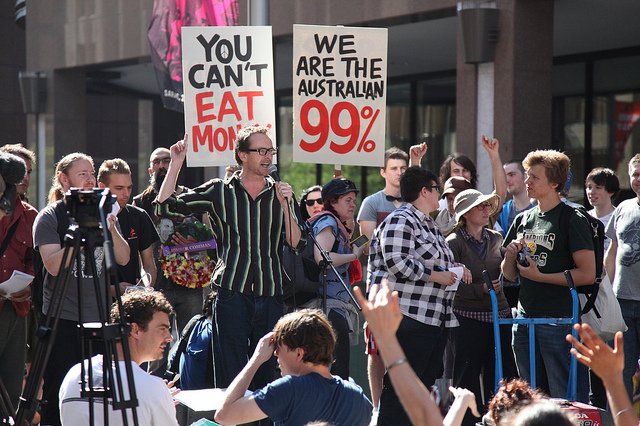
Before the first Australian occupations following the example of Occupy Wall Street began on October 15, even some of the activists involved wondered if it would work. After all, this was the “lucky country” that escaped the global financial crisis.
But thousands of mostly young people rocked up to launch Occupy Melbourne in City Square, and a further 1000 launched Occupy Sydney in Martin Place in the heart of the city’s financial district. Hundreds launched Occupy Brisbane in Post Office Square.
Most who visited these makeshift campsites were infected by the sense of excitement summed up in the slogans “We are the 99%” and “This is our moment”. Around the world, people are seizing the moment to revolt against the tyranny of the richest 1%, whose power has grown intolerable.
But surely this was nothing but flash-in-the-pan mimicry by a small minority in an overwhelmingly contented Australia, sneered the cynics.
Yet Occupy campsites continued for a week in Melbourne and Sydney, and 18 days in Brisbane before they were violently shut down by police. There have been several attempts to re-establish campsites in these cities. Marches against the evictions have drawn thousands in Melbourne and Sydney.
Occupy Perth began on October 28 and lasted several days under intense police pressure.
An October 31 Essential Report survey found 29% of Australians support the Occupy movement’s concerns and protests, while 40% agreed with the concerns, but didn’t agree with the action.
It also found 42% backed police action to break up the protests while 41% said they should have been allowed to go on.
Only 13% didn’t agree with the Occupy movement's concerns.
This reveals significant, if still largely passive, public support for this movement even in the “lucky country”.
How does this compare with public opinion in the US?
US polls have found that about 43% agree with views of Occupy Wall Street while 35% support the actual Occupy Wall Street protests. Only 16% support Wall Street and the large corporations, 71% have an “unfavourable impression” of big business and the government, and 58% are “furious” about US politics.

The general level of sympathy in Australia with the Occupy movement’s message against the “tyranny of the 1%” is large and not that far behind public opinion in the US.
Why is this so? Here are some reasons:
1. The wave of revolt against three-and-a-half decades of capitalist neoliberal offensive — the cutbacks, privatisation, wage restraint and the "free market" ideology — has been building up for some time. The anti-corporate globalisation movement that shook the world 10 years ago was an expression of this.
2. That movement may have been knocked back by the September 11, 2001 terror attacks and the West’s “war on terror”, but public distaste for neoliberalism continued. The widespread sentiment against corporate wealth continued to be reflected in popular culture, if mostly disconnected from collective political action. A collapse of public support for unending wars "against terrorism" added to a sense of mass disenfranchisement even in the richest capitalist "democracies".
3. The global financial crisis provoked huge outrage when the greedy banks were bailed out and workers paid through austerity and unemployment. When this was followed by ridiculous corporate bonuses on Wall Street, it only rubbed salt in the wound.
4. Even in Australia, which has so far escaped the pain of recession, people are now much more insecure than before. Full-time jobs now make up only 55% of jobs — down from nearly 75% in the early 1990s, an ACTU-commissioned workplace research report found.
Casual jobs, fixed or short-term contracts, labour hire and contracting now account for about 40% of the workforce. Casual employment has almost doubled in 25 years. Wages as a share of the overall economy in Australia was at near 45-year lows as profits surged, while the household debt-to-income ratio had risen from about 40% in 1980 to more than 150%.
5. The 99% in Australia can see the economic nightmare besetting the US and Europe and are reminded constantly by the 1% and their political servants about how “globalisation” works against the 99%. Peter Reith, the hated minister for workplace relations under the former Howard Coalition government, gave a blunt reminder of this on ABC TV's November 7 Q&A program.
He said: “It is great if we can have businesses that provide job security. But in the end, whether or not you can keep your job depends on whether or not that company can be competitive.” Qantas workers cannot have job security, Reith added, because “Qantas is basically 20-25% less competitive than a lot of the firms with whom it is competing”.
There are differences in the political terrain confronting the Occupy movement in the US to that in Australia. The sheer mass of unemployed and homeless in the US, where about 49 million people live in poverty, means that it is easier to keep long-term occupations going than in Australia.
After a short "honeymoon" period the Occupy movement in Australia is being forced to think up and test out new ways to continue the occupations. Small tentless occupations, regular decision-making general assemblies and mushrooming working groups — often held under police scrutiny in the original occupation sites — protests against the "towers of power" of the 1%, and free schools and workshops continue to draw people in.
The Australian Occupy movement's future hangs on whether it can come up with effective tactics to reach out to, empower and activate the much larger base of still mostly passive public support.
The movement here inevitably looks for global initiatives from Occupy Wall Street. Canandian magazine Adbusters is promoting a "December 10 Global Day of Action" and a "November 25 Buy Nothing Day kick off to #OCCUPYXMAS”.